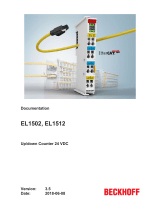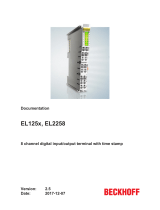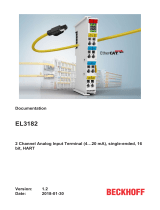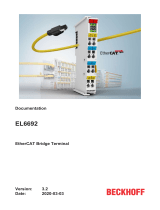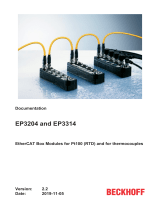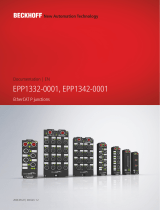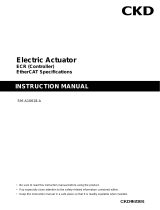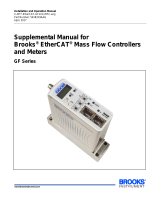Page is loading ...

Documentation
EL3632
2 channel analog input terminal for Condition Monitoring
(IEPE)
2.8
2018-09-14
Version:
Date:


Table of contents
EL3632 3Version: 2.8
Table of contents
1 Foreword ....................................................................................................................................................5
1.1 Notes on the documentation..............................................................................................................5
1.2 Safety instructions .............................................................................................................................6
1.3 Documentation issue status ..............................................................................................................7
1.4 Version identification of EtherCAT devices .......................................................................................8
2 Product overview.....................................................................................................................................12
2.1 Introduction......................................................................................................................................12
2.2 Technical data .................................................................................................................................13
2.3 Technology ......................................................................................................................................14
2.3.1 Vibration analysis............................................................................................................. 14
2.3.2 Application of condition monitoring .................................................................................. 14
2.3.3 Output signals of IEPE sensors ....................................................................................... 15
2.3.4 Basic principles of IEPE technology ................................................................................ 17
2.3.5 Beckhoff EL3632 ............................................................................................................. 18
2.4 Start .................................................................................................................................................19
3 Basics communication ...........................................................................................................................20
3.1 EtherCAT basics..............................................................................................................................20
3.2 EtherCAT cabling – wire-bound.......................................................................................................20
3.3 General notes for setting the watchdog...........................................................................................21
3.4 EtherCAT State Machine.................................................................................................................23
3.5 CoE Interface...................................................................................................................................25
3.6 Distributed Clock .............................................................................................................................30
4 Mounting and wiring................................................................................................................................31
4.1 Instructions for ESD protection........................................................................................................31
4.2 Installation on mounting rails ...........................................................................................................31
4.3 Installation instructions for enhanced mechanical load capacity .....................................................34
4.4 Positioning of passive Terminals .....................................................................................................35
4.5 Connection ......................................................................................................................................36
4.5.1 Connection system .......................................................................................................... 36
4.5.2 Wiring............................................................................................................................... 38
4.5.3 Shielding .......................................................................................................................... 39
4.6 ATEX - Special conditions (standard temperature range) ...............................................................39
4.7 ATEX Documentation ......................................................................................................................40
4.8 UL notice .........................................................................................................................................40
4.9 LEDs and connection ......................................................................................................................41
5 Commissioning........................................................................................................................................43
5.1 TwinCAT Quick Start .......................................................................................................................43
5.1.1 TwinCAT2 ....................................................................................................................... 46
5.1.2 TwinCAT 3 ....................................................................................................................... 56
5.2 TwinCAT Development Environment ..............................................................................................68
5.2.1 Installation of the TwinCAT real-time driver..................................................................... 68
5.2.2 Notes regarding ESI device description........................................................................... 74
5.2.3 TwinCAT ESI Updater ..................................................................................................... 78

Table of contents
EL36324 Version: 2.8
5.2.4 Distinction between Online and Offline............................................................................ 78
5.2.5 OFFLINE configuration creation ...................................................................................... 79
5.2.6 ONLINE configuration creation ........................................................................................ 84
5.2.7 EtherCAT subscriber configuration.................................................................................. 92
5.3 General Notes - EtherCAT Slave Application................................................................................101
5.4 Oversampling terminals/boxes and TwinCAT Scope ....................................................................109
5.4.1 TwinCAT 3 procedure.................................................................................................... 110
5.4.2 TwinCAT 2 procedure.................................................................................................... 118
5.5 Basics and commissioning ............................................................................................................127
5.5.1 Commissioning .............................................................................................................. 127
5.5.2 Update of the terminal ................................................................................................... 151
5.6 CoE object description...................................................................................................................152
5.6.1 Profile-specific and parameterization objects ................................................................ 152
5.6.2 Standard objects and PDO mapping ............................................................................. 155
5.7 Notices on analog specifications ...................................................................................................172
5.7.1 Full scale value (FSV).................................................................................................... 172
5.7.2 Measuring error/ measurement deviation ...................................................................... 172
5.7.3 Temperature coefficient tK [ppm/K] ............................................................................... 173
5.7.4 Single-ended/differential typification .............................................................................. 174
5.7.5 Common-mode voltage and reference ground (based on differential inputs)................ 179
5.7.6 Dielectric strength .......................................................................................................... 179
5.7.7 Temporal aspects of analog/digital conversion.............................................................. 180
5.8 Application example ......................................................................................................................183
6 Error handling and diagnostics............................................................................................................186
6.1 Error descriptions and troubleshooting..........................................................................................186
7 Appendix ................................................................................................................................................187
7.1 EtherCAT AL Status Codes...........................................................................................................187
7.2 Diagnostics – basic principles of diag messages ..........................................................................187
7.3 Firmware compatibility...................................................................................................................196
7.4 Firmware Update EL/ES/EM/ELM/EPxxxx ....................................................................................197
7.4.1 Device description ESI file/XML..................................................................................... 198
7.4.2 Firmware explanation .................................................................................................... 201
7.4.3 Updating controller firmware *.efw................................................................................. 202
7.4.4 FPGA firmware *.rbf....................................................................................................... 203
7.4.5 Simultaneous updating of several EtherCAT devices.................................................... 207
7.5 Restoring the delivery state ...........................................................................................................208
7.6 Support and Service ......................................................................................................................209

Foreword
EL3632 5Version: 2.8
1 Foreword
1.1 Notes on the documentation
Intended audience
This description is only intended for the use of trained specialists in control and automation engineering who
are familiar with the applicable national standards.
It is essential that the documentation and the following notes and explanations are followed when installing
and commissioning these components.
It is the duty of the technical personnel to use the documentation published at the respective time of each
installation and commissioning.
The responsible staff must ensure that the application or use of the products described satisfy all the
requirements for safety, including all the relevant laws, regulations, guidelines and standards.
Disclaimer
The documentation has been prepared with care. The products described are, however, constantly under
development.
We reserve the right to revise and change the documentation at any time and without prior announcement.
No claims for the modification of products that have already been supplied may be made on the basis of the
data, diagrams and descriptions in this documentation.
Trademarks
Beckhoff
®
, TwinCAT
®
, EtherCAT
®
, EtherCATP
®
, SafetyoverEtherCAT
®
, TwinSAFE
®
, XFC
®
and XTS
®
are
registered trademarks of and licensed by Beckhoff Automation GmbH.
Other designations used in this publication may be trademarks whose use by third parties for their own
purposes could violate the rights of the owners.
Patent Pending
The EtherCAT Technology is covered, including but not limited to the following patent applications and
patents: EP1590927, EP1789857, DE102004044764, DE102007017835 with corresponding applications or
registrations in various other countries.
The TwinCAT Technology is covered, including but not limited to the following patent applications and
patents: EP0851348, US6167425 with corresponding applications or registrations in various other countries.
EtherCAT
®
is registered trademark and patented technology, licensed by Beckhoff Automation GmbH,
Germany.
Copyright
© Beckhoff Automation GmbH & Co. KG, Germany.
The reproduction, distribution and utilization of this document as well as the communication of its contents to
others without express authorization are prohibited.
Offenders will be held liable for the payment of damages. All rights reserved in the event of the grant of a
patent, utility model or design.

Foreword
EL36326 Version: 2.8
1.2 Safety instructions
Safety regulations
Please note the following safety instructions and explanations!
Product-specific safety instructions can be found on following pages or in the areas mounting, wiring,
commissioning etc.
Exclusion of liability
All the components are supplied in particular hardware and software configurations appropriate for the
application. Modifications to hardware or software configurations other than those described in the
documentation are not permitted, and nullify the liability of Beckhoff Automation GmbH & Co. KG.
Personnel qualification
This description is only intended for trained specialists in control, automation and drive engineering who are
familiar with the applicable national standards.
Description of instructions
In this documentation the following instructions are used.
These instructions must be read carefully and followed without fail!
DANGER
Serious risk of injury!
Failure to follow this safety instruction directly endangers the life and health of persons.
WARNING
Risk of injury!
Failure to follow this safety instruction endangers the life and health of persons.
CAUTION
Personal injuries!
Failure to follow this safety instruction can lead to injuries to persons.
NOTE
Damage to environment/equipment or data loss
Failure to follow this instruction can lead to environmental damage, equipment damage or data loss.
Tip or pointer
This symbol indicates information that contributes to better understanding.

Foreword
EL3632 7Version: 2.8
1.3 Documentation issue status
Version Comment
2.8 • Chapter "Diag Messages" added
• Update structure
• Update revision status
2.7 • Update chapter "LEDs and connection”
2.6 • Update chapter "Technology"
• Update structure
• Update revision status
2.5 • Update chapter "Technical data"
• Addenda chapter "Instructions for ESD protection"
• Update chapter "Notices on Analog specification"
• Addenda chapter "Installation instructions for enhanced mechanical load capacity"
2.4 • Update chapter "LEDs and connection"
• Addenda chapter “Notices on analog specifications”
2.3 • Update chapter "Notes on the documentation"
• Correction of Technical data
• Update chapter "TwinCAT 2.1x" -> "TwinCAT Development Environment" and
"TwinCAT Quick Start"
• Update revision status
2.2 • Section “Oversampling terminals and TwinCAT Scope” added
2.1 • Update chapter "Object description"
• Update chapter "Technology"
• Update revision status
2.0 • Migration
• Update structure
• Update revision status
2.0 • Migration
• Update structure
• Update revision status
1.6 • Update chapter "Object description"
• Update chapter "Firmware status"
• Update structure
1.5 • Update chapter "Object description"
• Update chapter "Technical data"
• Update chapter "Firmware status"
• Update structure
1.4 • Update Technical data
1.3 • Update chapter "Technology"
• Update chapter "Firmware status"
1.2 • Addenda chapter "Technology"
1.1 • Addenda chapter "Technical data"
1.0 • Amendments
• 1. Publication
0.1 • Preliminary documentation for EL3632

Foreword
EL36328 Version: 2.8
1.4 Version identification of EtherCAT devices
Designation
A Beckhoff EtherCAT device has a 14-digit designation, made up of
• family key
• type
• version
• revision
Example Family Type Version Revision
EL3314-0000-0016 EL terminal
(12 mm, non-
pluggable connection
level)
3314 (4-channel thermocouple
terminal)
0000 (basic type) 0016
ES3602-0010-0017 ES terminal
(12 mm, pluggable
connection level)
3602 (2-channel voltage
measurement)
0010 (high-
precision version)
0017
CU2008-0000-0000 CU device 2008 (8-port fast ethernet switch) 0000 (basic type) 0000
Notes
• The elements mentioned above result in the technical designation. EL3314-0000-0016 is used in the
example below.
• EL3314-0000 is the order identifier, in the case of “-0000” usually abbreviated to EL3314. “-0016” is the
EtherCAT revision.
• The order identifier is made up of
- family key (EL, EP, CU, ES, KL, CX, etc.)
- type (3314)
- version (-0000)
• The revision -0016 shows the technical progress, such as the extension of features with regard to the
EtherCAT communication, and is managed by Beckhoff.
In principle, a device with a higher revision can replace a device with a lower revision, unless specified
otherwise, e.g. in the documentation.
Associated and synonymous with each revision there is usually a description (ESI, EtherCAT Slave
Information) in the form of an XML file, which is available for download from the Beckhoff web site.
From 2014/01 the revision is shown on the outside of the IP20 terminals, see Fig. “EL5021 EL terminal,
standard IP20 IO device with batch number and revision ID (since 2014/01)”.
• The type, version and revision are read as decimal numbers, even if they are technically saved in
hexadecimal.
Identification number
Beckhoff EtherCAT devices from the different lines have different kinds of identification numbers:
Production lot/batch number/serial number/date code/D number
The serial number for Beckhoff IO devices is usually the 8-digit number printed on the device or on a sticker.
The serial number indicates the configuration in delivery state and therefore refers to a whole production
batch, without distinguishing the individual modules of a batch.
Structure of the serial number: KKYYFFHH
KK - week of production (CW, calendar week)
YY - year of production
FF - firmware version
HH - hardware version

Foreword
EL3632 9Version: 2.8
Example with
Ser. no.: 12063A02: 12 - production week 12 06 - production year 2006 3A - firmware version 3A 02 -
hardware version 02
Exceptions can occur in the IP67 area, where the following syntax can be used (see respective device
documentation):
Syntax: D ww yy x y z u
D - prefix designation
ww - calendar week
yy - year
x - firmware version of the bus PCB
y - hardware version of the bus PCB
z - firmware version of the I/O PCB
u - hardware version of the I/O PCB
Example: D.22081501 calendar week 22 of the year 2008 firmware version of bus PCB: 1 hardware version
of bus PCB: 5 firmware version of I/O PCB: 0 (no firmware necessary for this PCB) hardware version of I/O
PCB: 1
Unique serial number/ID, ID number
In addition, in some series each individual module has its own unique serial number.
See also the further documentation in the area
• IP67: EtherCAT Box
• Safety: TwinSafe
• Terminals with factory calibration certificate and other measuring terminals
Examples of markings
Fig.1: EL5021 EL terminal, standard IP20 IO device with serial/ batch number and revision ID (since
2014/01)

Foreword
EL363210 Version: 2.8
Fig.2: EK1100 EtherCAT coupler, standard IP20 IO device with serial/ batch number
Fig.3: CU2016 switch with serial/ batch number
Fig.4: EL3202-0020 with serial/ batch number 26131006 and unique ID-number 204418

Foreword
EL3632 11Version: 2.8
Fig.5: EP1258-00001 IP67 EtherCAT Box with batch number/ date code 22090101 and unique serial
number 158102
Fig.6: EP1908-0002 IP67 EtherCAT Safety Box with batch number/ date code 071201FF and unique serial
number 00346070
Fig.7: EL2904 IP20 safety terminal with batch number/ date code 50110302 and unique serial number
00331701
Fig.8: ELM3604-0002 terminal with unique ID number (QR code) 100001051 and serial/ batch number
44160201

Product overview
EL363212 Version: 2.8
2 Product overview
2.1 Introduction
Fig.9: EL3632
2-channel analog input terminal for Condition Monitoring (IEPE)
Accelerometers with IEPE interface can be directly connected to the EL3632 EtherCAT Terminal. The
measuring signals are analyzed on the PC via the TwinCAT library. This enables all benefits of the PC
platform, such as performance and flexibility, to be fully utilized. Alternatively, the evaluation can also be
done using the user software. The terminal can be adapted to individual requirements through configurable
filters and supply currents.
A galvanically isolated measurement configuration can be achieved using the EL9560. Through interfacing
via EtherCAT and support of the distributed clocks function the measurement results – and any detected
defects – can be precisely allocated to an axis position.
Quick links
• EtherCAT basic function principles
• IEPE - Technology, areas of application, function [}14]
• Basic function principles EL3632 [}127]

Product overview
EL3632 13Version: 2.8
2.2 Technical data
Technical data EL3632
Number of inputs 2
Measuring range preset ±5V up to 25kHz, ±250mV up to 10Hz
Supply voltage 24V
DC
via power contacts
U
EXCITE
U
V
-1Vtyp.
Sensor state monitoring yes, through monitoring of the bias voltage
Supply current I
EXCITE
typ. 2mA/4mA/8mA (separately adjustable for both
channels)
Input filter limit frequency analog parameterisable 5
th
order low-pass filter up to
25KHz
typ. 0.05Hz high-pass
Max. sampling rate 50 kSamples/s
Input single ended
AC coupling 0.05Hz typ.
Resolution 16bit
Measuring error 0,5%
Supply voltage for electronic via the E-bus
Current consumption via E-bus typ. 220mA
Configuration via TwinCAT System Manager
Weight approx. 65g
Permissible ambient temperature range during
operation
0°C ... + 55°C
Permissible ambient temperature range during
storage
-25°C ... + 85°C
Permissible relative humidity 95%, no condensation
Dimensions (W x H x D) approx. 15mm x 100mm x 70mm (width aligned:
12mm)
Mounting [}31]
on 35mm mounting rail conforms to EN 60715
Vibration/shock resistance conforms to EN 60068-2-6 / EN 60068-2-27,
see also installation instructions for terminals with
increased mechanical load capacity [}34]
EMC immunity/emission conforms to EN 61000-6-2 / EN 61000-6-4
Protection class IP20
Installation position variable
Approval CE
cULus [}40]
ATEX [}39]

Product overview
EL363214 Version: 2.8
2.3 Technology
2.3.1 Vibration analysis
Vibration analysis refers to deriving of information from existing (mechanical) vibrations e.g. in machines or
certain production processes. It can take place during Condition Monitoring, e.g. for drives, punching and
pressing tools, in production processes such as balancing of rotating parts, or during other movements such
as torsion of towers/wind turbines.
The table below illustrates typical acceleration values for natural and technical processes.
Typical acceleration values
Machine or event Typical g-value
Commercial aircraft (take-off) ≈ 0,5
Formula 1 car (start) ≈ 1 – 1,5
Commercial aircraft (turning, max.) ≈ 2,5
Pendulum at 90° amplitude ≈ 2
Space Shuttle during journey into orbit max. 3 (exact)
Space Shuttle during re-entry into the Earth's atmosphere max. 1.6
Typical roller coaster ride (max.) 4 (6)
Formula 1 car (cornering, max.) ≈ 4 – 5
Circular looping (base) ≥ 6
Combat aircraft/aerobatics (max.) ≈ 10 (13,8)
Ejector seat 15 – 20
Car back-rest breaks at ≈ 20
Head-on car collision up to ≈ 50
Car passenger compartment during crash max. 120
Survived by a human ≈ 180
Hard fist stroke up to ≈ 100
Raindrop hitting the eye up to ≈ 150
Ball pen hitting hard floor from 1 m height order of magnitude 1000
Hard disk falling on hard floor from 1 m height (without deformation of the floor) 10,000 or more
Laboratory centrifuge ≈ 10.000
Ultra centrifuge ≈ 100.000
Rifle bullet during firing ≈ 100.000
Spike during ejection from a nettle cell 5.410.000
Nuclear bomb explosion (bomb case) up to ≈ 10
11
Neutron star surface ≈ 2·10
11
2.3.2 Application of condition monitoring
Condition monitoring can be used to glean information on the state of rotating/moving parts through
measurement of vibrations at machines/drives/gears and subsequent analysis with suitable mathematical
tools (e.g. TwinCAT library, FFT, custom user programs).
The existing vibration is recorded continuously or at longer, regular time intervals and finally compared with a
setpoint value/initial value (Fig. Sample of ball bearing damage and subsequent analysis).
In this way any damage can be detected at an early stage. Instead of changing components preventively on
a regular basis or waiting for sudden damage and subsequent expensive downtime and possible
consequential damage, repairs and downtimes become plannable. Needless failures, consequential damage
or prematurely and costly replacement of intact parts can be avoided.

Product overview
EL3632 15Version: 2.8
Fig.10: Example of ball bearing damage and subsequent analysis
In the example above the so-called envelope enables analysis of shock pulses resulting from unevenness in
the roller bearing. The defective element can be identified based on the periodicity (envelope spectrum).
2.3.3 Output signals of IEPE sensors
Vibrations can be recorded with IEPE (Integrated Electronics Piezo Electric) sensors, for example. The
advantage of this technology is an integrated amplifier as impedance transformer, so that only a simple two-
wire connection (coax) is required for the low-impedance output signal. IEPE sensors are typically supplied
with 2…20mA constant current. In inactive state they produce a constant DC bias voltage (zero voltage/
U
bias
) typically 7…14 V. Depending on the acceleration of the sensor, an analog AC voltage generated
proportionally to the movement is added to the sensor's U
bias
; e.g. a 50 Hz sinusoidal deflection with an
amplitude of 1 g (= 9.81m/s
2
) produces a 50Hz sinusoidal output voltage of AC +/-50mV + U
bias
in the case
of a sensor with a sensitivity of 50mV/g (Fig. Output signal of an IEPE sensor (sample)). The maximum
output signal of a sensor is usually AC +/-5V (+ U
bias
).
Increasing cable length results in increasing cable capacitance (typically 100pF/m), so that the control
capability of the integrated amplifier drops with increasing signal frequency. This can be partly compensated
by increasing the supply current (Fig. Control capability of the IEPE impedance transformer depending on
cable capacitance and supply current).

Product overview
EL363216 Version: 2.8
Fig.11: Control capability of the IEPE impedance transformer depending on cable capacitance and supply
current.
The basic properties of IEPE acceleration sensors are described by various parameters such as sensitivity
(e.g. 50 mV/g), measuring range (e.g. +/-100g), +/-3dB frequency range (under 1Hz to several kHz),
current consumption (2…20mA), bias voltage etc. The figure Frequency response of an acceleration sensor
shows an example of a frequency response (amplitude of the output signal in relation to the frequency).
Fig.12: Output signal of an IEPE sensor (sample)

Product overview
EL3632 17Version: 2.8
Fig.13: Frequency response of an acceleration sensor
Other proprietary names for this electrical technique include DeltaTron®, Isotron™, ICP™, Piezotron™ or
CCLD
Note: At their core IEPE sensors usually have quartz crystals, which experience small charge changes due
to the motion. Measuring and transporting these over several meters requires complex cable installations
and measuring instruments for charge amplification. For cost-effective and robust application in industrial
environments the solution is to integrate a simple charge amplifier as impedance transformer in the sensor.
This enables it to generate the above-mentioned voltage signal and transport the vibration information over
larger distance (several tens ofmeters).
2.3.4 Basic principles of IEPE technology
IEPE ("Integrated Electronics Piezo-Electric") is the standardized name for an analog electrical interface
between piezoelectric sensors and electronic analysis equipment. Different manufacturers have developed
their own brand names, such as ICP®, CCLD®, Isotron®, DeltaTron®, Piezotron®.
Application
Piezoelectric sensors are usually based on a quartz, in which an electrical charge is shifted under
mechanical load. The charge can be detected as a voltage if the measurement is made with sufficiently high
impedance. This is preferably a static process <<10seconds, since otherwise the charge difference is
dissipated through external or internal derivative. Such a sensor is therefore less suitable for static long-term
loads, such as weighing a silo. Such sensors tend to be used for all kinds of vibration measurements
(unbalance detection, sound signals via microphones up to ultrasound, mechanical vibrations, foundation
monitoring, etc.).
Over the decades, two electrical forms have developed:
• Direct charge output
• IEPE output
Charge output
If the voltage information is obtained directly via a (short) two-pole cable, the electronic measuring system
must be a so-called charge amplifier.
Advantage: the sensor can be exposed to high temperatures > 150 °C; no power supply is required.

Product overview
EL363218 Version: 2.8
Disadvantage: very sensitive to external influences on the line; elaborate receiving electronics and cable
due to high source impedance.
IEPE output
Since the load interface is not generally accepted for industrial applications, a more robust transfer method
was sought at an early stage. To this end, IEPE integrates a FET component directly in the sensor.
If this sensor is supplied with constant current between 2 and 8 mA (DC) via the two-pole cable, the resulting
bias voltage is approx. 8 to 15 V. If the sensor is now subjected to an accelerating force, the FET changes its
internal resistance by the present voltage on its gate. Since the outer constant current source tries to
maintain its current, the bias voltage changes within a range of several volts, according to the mechanical
load. Although the evaluation unit has to supply the DC current, it can derive the vibration acceleration from
the back-measured voltage, even over longer distances.
Advantage: robust system, which is suitable for installation in industrial conditions.
Disadvantage: upper temperature limit for the sensor 150 to 200 °C, smaller dynamic range.
Notes on constant current
• The higher the feed current, the more the vibration sensor heats up. This can be disadvantageous.
Note the information provided by the sensor manufacturer.
• The higher the feed current, the higher the maximum transferable signal frequency, since the charge
supply/discharge can be handled more quickly on the cable.
• The higher the supply current, the higher the resulting bias voltage. As a result, the transfer may
become more robust against electromagnetic influence, but on the other hand large positive
amplitudes may enter the upper saturation.
Notes on the IEPE measuring device
• In some IEPE measuring devices the supply current can be switched off (0 mA), so that they can be
used for voltage measurements. Cf. for example Beckhoff ELM3604
• Since normally only AC signals are of interest in the vibration range, IEPE evaluations have an
electrical high-pass >10Hz on the input side. Depending on the application e.g. slow tower vibrations,
the limit of this high-pass may be relevant. Cf. for example the configurable high-pass of the ELM3604,
which can be switched off.
• The bias voltage is suitable for detection of wire breakage/short circuit. E.g. see also ELM3604
diagnostics options.
2.3.5 Beckhoff EL3632
A suitable measuring transducer is the EL3632 with two independent channels, each with an integrated and
separately configurable current source, integrated high-pass filter, separately parameterisable analog filter
for signal processing and parameterisable sampling rate/oversampling factor. The EL3632 does not pre-

Product overview
EL3632 19Version: 2.8
analyses the vibration data but transports the continuous amplitude information to the EtherCAT master. The
master analyses the measured data on the existing higher-level PC via the TwinCAT library or custom
software.
Fig.14: EL3632 with periphery
2.4 Start
For commissioning:
• mount the EL3632 as described in the chapter Mounting and wiring [}31]
• configure the EL3632 in TwinCAT as described in the chapter Commissioning [}43].

Basics communication
EL363220 Version: 2.8
3 Basics communication
3.1 EtherCAT basics
Please refer to the EtherCAT System Documentation for the EtherCAT fieldbus basics.
3.2 EtherCAT cabling – wire-bound
The cable length between two EtherCAT devices must not exceed 100 m. This results from the FastEthernet
technology, which, above all for reasons of signal attenuation over the length of the cable, allows a maximum
link length of 5 + 90 + 5 m if cables with appropriate properties are used. See also the Design
recommendations for the infrastructure for EtherCAT/Ethernet.
Cables and connectors
For connecting EtherCAT devices only Ethernet connections (cables + plugs) that meet the requirements of
at least category 5 (CAt5) according to EN 50173 or ISO/IEC 11801 should be used. EtherCAT uses 4 wires
for signal transfer.
EtherCAT uses RJ45 plug connectors, for example. The pin assignment is compatible with the Ethernet
standard (ISO/IEC 8802-3).
Pin Color of conductor Signal Description
1 yellow TD + Transmission Data +
2 orange TD - Transmission Data -
3 white RD + Receiver Data +
6 blue RD - Receiver Data -
Due to automatic cable detection (auto-crossing) symmetric (1:1) or cross-over cables can be used between
EtherCAT devices from Beckhoff.
Recommended cables
Suitable cables for the connection of EtherCAT devices can be found on the Beckhoff website!
E-Bus supply
A bus coupler can supply the EL terminals added to it with the E-bus system voltage of 5V; a coupler is
thereby loadable up to 2A as a rule (see details in respective device documentation).
Information on how much current each EL terminal requires from the E-bus supply is available online and in
the catalogue. If the added terminals require more current than the coupler can supply, then power feed
terminals (e.g. EL9410) must be inserted at appropriate places in the terminal strand.
The pre-calculated theoretical maximum E-Bus current is displayed in the TwinCAT System Manager. A
shortfall is marked by a negative total amount and an exclamation mark; a power feed terminal is to be
placed before such a position.
/
